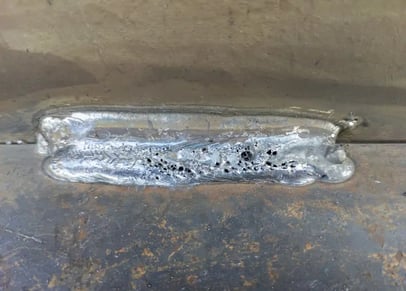Recognizing What is Porosity in Welding: Causes and Solutions
Wiki Article
Comprehending Porosity in Welding: Exploring Reasons, Results, and Prevention Methods
As experts in the welding market are well aware, recognizing the causes, effects, and prevention strategies connected to porosity is crucial for achieving durable and reliable welds. By delving right into the origin causes of porosity, analyzing its detrimental effects on weld top quality, and discovering reliable prevention techniques, welders can enhance their expertise and abilities to create top notch welds consistently.Typical Sources Of Porosity
Porosity in welding is largely triggered by a combination of elements such as contamination, improper protecting, and inadequate gas insurance coverage during the welding process. Contamination, in the type of dust, oil, or corrosion on the welding surface, produces gas pockets when heated up, causing porosity in the weld. Incorrect securing happens when the protecting gas, commonly made use of in procedures like MIG and TIG welding, is not able to totally shield the liquified weld swimming pool from responding with the bordering air, leading to gas entrapment and succeeding porosity. Additionally, insufficient gas insurance coverage, often as a result of incorrect circulation rates or nozzle positioning, can leave components of the weld unprotected, enabling porosity to create. These elements collectively contribute to the formation of voids within the weld, weakening its stability and possibly creating structural problems. Comprehending and dealing with these usual causes are essential steps in preventing porosity and making certain the top quality and toughness of welded joints.Impacts on Weld High Quality
The existence of porosity in a weld can substantially compromise the overall quality and stability of the bonded joint. Porosity within a weld creates spaces or cavities that compromise the structure, making it extra prone to splitting, rust, and mechanical failing. These voids act as tension concentrators, minimizing the load-bearing ability of the weld and increasing the chance of premature failing under used stress and anxiety. Additionally, porosity can also work as possible sites for hydrogen entrapment, additional exacerbating the degradation of the weld's mechanical buildings.Furthermore, porosity can impede the effectiveness of non-destructive screening (NDT) methods, making it challenging to identify other problems or discontinuities within the weld. This can result in significant safety problems, especially in essential applications where the architectural honesty of the bonded components is critical.

Avoidance Techniques Summary
Provided the destructive impact of porosity on weld high quality, effective avoidance techniques are essential to preserving the structural integrity of bonded joints. In addition, choosing the appropriate welding criteria, such as voltage, present, and take a trip rate, can assist minimize the danger of porosity formation. By incorporating these prevention methods right into welding techniques, the occurrence of porosity can be substantially decreased, leading to more powerful and a lot more reputable welded joints.Value of Proper Shielding
Proper securing in welding plays a crucial duty in avoiding atmospheric contamination and making certain the stability of welded joints. Securing gases, such as argon, helium, or a mix of both, are frequently made use of to protect the weld pool from responding with components airborne like oxygen and nitrogen. When these responsive elements enter call with the warm weld swimming pool, they can trigger porosity, bring about weak welds with lowered mechanical homes.
Inadequate shielding can result in numerous flaws like porosity, spatter, and oxidation, endangering the structural integrity of the welded joint. Adhering to appropriate protecting methods is vital to create premium welds with very little issues and make certain the long life and integrity of the bonded parts.
Surveillance and Control Techniques
Exactly how can welders successfully keep an eye on and manage the welding process to ensure optimum outcomes and prevent problems like porosity? One secret technique is through using sophisticated monitoring innovations. These can include real-time tracking systems that provide feedback on parameters such as voltage, existing, take a trip speed, and gas circulation prices. By continuously keeping an eye on these variables, welders can recognize inconsistencies from the excellent problems and make prompt adjustments to stop porosity formation.
Furthermore, applying proper training programs for welders is vital for keeping track of and regulating the welding process properly. What is Porosity. Educating welders on the significance of preserving regular criteria, such as proper gas shielding and travel speed, can assist stop porosity concerns. Normal analyses and certifications can also guarantee that welders excel in surveillance and regulating welding procedures
Furthermore, the usage of automated welding systems check my blog can enhance surveillance and control capabilities. These systems can exactly control welding criteria, decreasing the probability of human mistake and ensuring constant weld top quality. By combining sophisticated monitoring technologies, training programs, and automated systems, welders can successfully monitor and control the welding process to lessen porosity issues and attain high-quality welds.
Conclusion

Report this wiki page